For the first time ever, the Bundeswehr’s Artillery School in Idar-Oberstein recently put the new German Panzerhaubitze 2000 (PzH 2000) self-propelled howitzer through its paces in front of a group of international journalists, including a live fire demonstration. Key themes of this informative presentation were the system’s extremely high performance parameters, as well as the principles governing deployment of the system, the reconnaissance potential of artillery, and – above all – the thorough training Germany’s artillerymen receive in the new weapons system.The commander of the Artillery School, Colonel Heinrich Fischer, who explained the technical aspects of this highly mobile system, stressed the PzH 2000’s status as the world’s most advanced and powerful artillery system. Since July 1st 1998, it has been gradually superseding the aging US-made M 109 A3 GE A1 self-propelled howitzer and the FH 70 field howitzer in the artillery units of the Bundeswehr. It has already been introduced in seven German artillery battalions. NATO partner states Greece and Holland have likewise recently ordered the PzH 2000.
Rheinmetall, a long-established Düsseldorf-based defence contractor, has a production share of over 50% in the self-propelled howitzer, making the largest single subcontractor involved in the project; (the general contractor is Krauss Maffei Wegmann (KMW) of Munich). Among other key components, the main armament and hull are made by Rheinmetall DeTec subsidiaries Rheinmetall W&M GmbH and Rheinmetall Landsysteme GmbH.
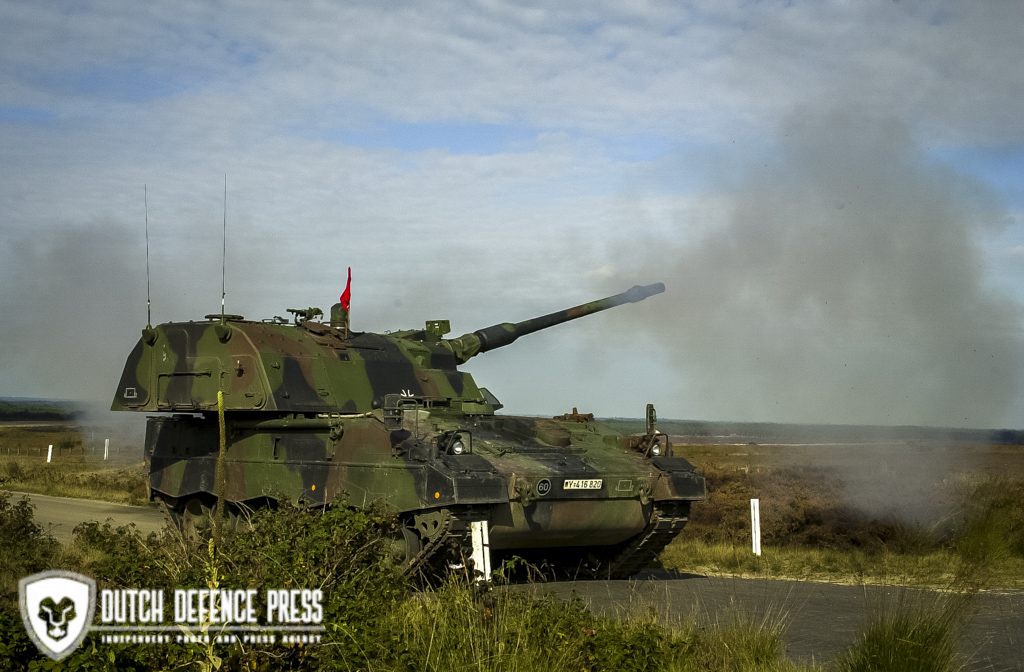
The Grounds for Modernisation: The possibility for creating a new artillery force structure was first discussed in the German Army in the mid 1980s. At the heart of the new military thinking was a concept incorporating reconnaissance, command and weapons systems, and corresponding to the requirements of the Bundeswehr. This new “Networked Artillery” system intended to make reconnaissance data available to barrel and rocket artillery units extremely quickly, thereby enabling them to engage enemy forces on the battlefield faster and more effectively. According to the Artillery School, the technologies necessary for this were developed by the German defence industry for the Bundeswehr started in the late eighties. These included the KZO reconnaissance UAV, the KDH attack drone, the Franco-German Polyphem guided missile, and the Adler artillery command and control system, which also constitutes a communications interface to the artillery units of allied armed forces (see annex).
Despite the fundamentally altered security situation in Europe, the German armed forces adhered to their new artillery concept, parts of which have since materialised. Forming the core of the new concept is the PzH 2000 self-propelled howitzer, whose technical aspects were presented in Idar-Oberstein.
The mission of Germany’s artillery corps: The German Army has the mission of defending German territory at home, as well as participating in crisis management and the defence of German allies outside of central Europe. It should also be possible to deploy German troops on a large scale in distant theatres. The German Army’s field, rocket and self-propelled artillery units support its combined arms operations with a combination of reconnaissance and fire. The existing flexibility and range of barrel weapons enable the artillery corps to operate quickly and comprehensively, shifting its focus from point to area targets in the enemy rear and back again, the objective being to destroy or suppress enemy artillery, field fortifications and logistical facilities, as well as stationary and moving targets situated close to friendly frontline troops. Particularly on account of the freely selectable trajectory and wide ammunition spectrum, artillery (155mm self-propelled and towed field howitzers) is capable of reacting flexibly to changes in the tactical situation and enemy target behaviour, applying fire in accordance with the current position, size and hardness of the target.
Today, an effective artillery system must incorporate the following characteristics: system survivability, the ability to defend itself, technical prerequisites enabling it to shift position quickly, the ability to redirect fire without delay, as well as protection from NBC threats and a defined degree of weapon effectiveness. Being able to react quickly on the battlefield implies the ability to move into an unprepared fire position at any time when on the move, and then in a matter of seconds to engage targets accurately and at a rapid rate of fire, all based on reliable ballistic data. Previously fielded 155mm weapon systems – the M 109 A3 GE A1 self-propelled howitzer and the FH 70 field howitzer – did not meet this requirement profile, making the introduction of a new 155mm self-propelled howitzer imperative.
Procurement of the PzH 2000 means that each battalion is now equipped with just 18 guns. To achieve the same effect, 24 M 109 A3 GE A1 or 24 field howitzers were necessary. The number of operating personnel can also be cut. While the M 109 howitzer requires a crew of eight, the PzH 2000 can get by with just five. In terms of howitzer operating crews, this represents potential savings of 53%, because instead of 192 soldiers per battalion (24 guns x 8 men), in future only 90 soldiers will be necessary (18 guns x 5 men).
The concept of the PzH 2000: The military and conceptual requirements imposed on a PzH 2000 for the armoured artillery units of the Bundeswehr were defined as follows: – 155mm L 52 main armament (barrel length = 52 calibre lengths), capable of firing standard NATO projectiles distances of up to 30 km, and delivering range-enhanced projectiles to targets up to 40 km away with a high degree of accuracy. – A high rate of fire, i.e. three rounds in ten seconds, twelve rounds per minute, and twenty rounds in 2.40 minutes. – An automatic shell loading mechanism with a magazine and a sixty round supply of shells. – Autonomous determination of direction, position and altitude. – Semiautonomous calculation of individual fire commands. – Automatic laying. – High mobility and NBC protection by means of steel armour, interior liners, reactive roof armour to protect against shaped charge bomblets, a collective NBC ventilation system, – and a crew of five soldiers (vehicle commander, driver, and three gunners).
Unsurpassed: the Rheinmetall W&M main gun: Particularly noteworthy is the main armament of the PzH 2000 developed by Rheinmetall W&M at its Unterlüß plant, a 155mm chrome-plated barrel measuring 52 calibre lengths. The barrel conforms to the specifications laid down in the Ballistic MoU signed by five NATO countries: France the United States, Germany, Italy and Great Britain. As a result, the PzH 2000 can fire any 155mm NATO projectile; this also applies to range-enhanced rounds, bag charges and highly advanced modular propelling charges (MTLS).
The 155mm barrel has a 2,000-round service life (when fired with the maximum charge). In an international comparison this design feature is considered to be a “master feat of German gun manufacture”. The PzH 2000 attains its greatest range when firing the L 15A1 reference projectile, attaining distances of up to 30,000 metres. With range-enhanced base bleed ammunition, ranges of up to 40,000 metres can be attained.
Muzzle brakes: The 155mm barrel of the PzH 2000 is fitted with a multi-slit muzzle brake and a cylindrical fume extractor. The height of the elevation mass can be adjusted to between -2.5° and +65°. According to the manufacturer, the maximum gun-laying speed of the PzH 2000 (both vertically and horizontally) comes to more than 200 mils per second. This equates to 11.25°. This high rate of speed was achieved by using an electrically powered laying unit in lieu of a conventional hydraulic drive. Shrapnel and antitank weapon shaped charges can quickly rip open hydraulic cables, spraying burning oil around the fighting compartment, resulting in the loss of the vehicle and its crew. Using an electrical drive effectively rules out this risk. Further more, electrical cables are easier to main and repair under field conditions.
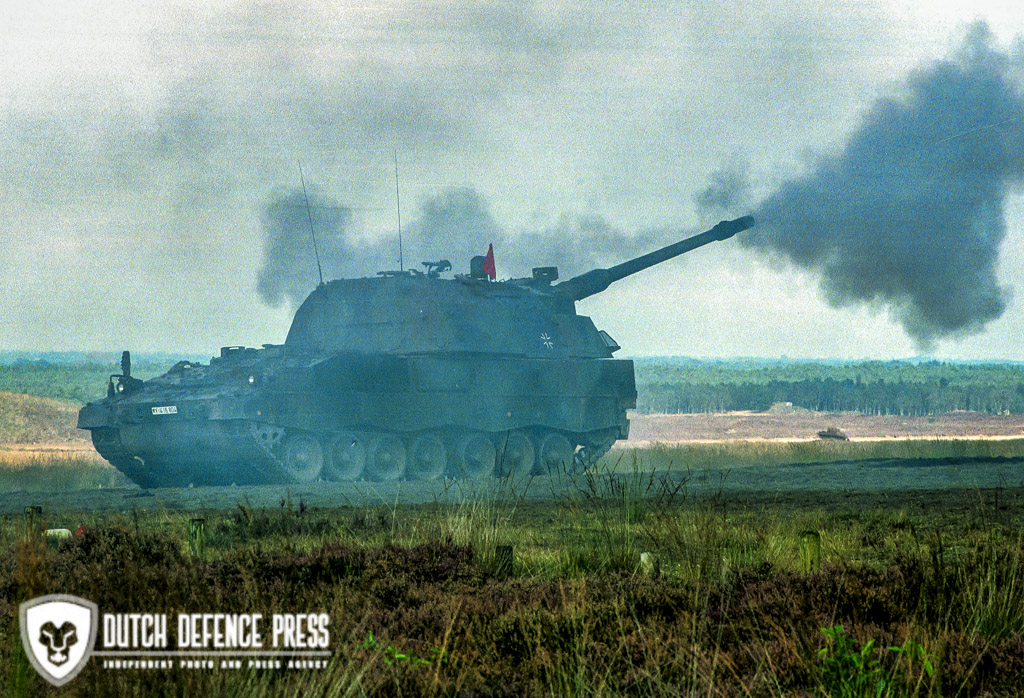
Automatic loading: In line with the military and technical doctrine of the Germany artillery corps, modern artillery systems must be capable of firing a burst of three rounds in just ten seconds. Likewise, a gun has to be able to fire eight rounds in one minute and a further six rounds in both of the following two minutes. These are stringent requirements, and the PzH 2000 is the world’s only self-propelled howitzer capable of meeting them.
The key to achieving this high rate of fire lay in the development of an automatic high-performance loader, now a feature of the PzH 2000. It automatically loads the 155mm projectile. All the gunner has to do by hand is to place the propelling charge into the barrel. The task of the propelling-charge gunner consists of preparing and subsequently loading the propelling charges, as well as operating the breech. This concludes the loading process, meaning that the round is now to fire. When operating in automatic mode, the PzH 2000 can be served by just three soldiers: the gun commander, the driver and the loader/ gunner.
The automatic rammer operates pneumatically and is supplied by an air compressor. Even if this fails, the stored compressed air is sufficient for firing every round of ammunition on board. To ease the task of the gunner, when the howitzer is being replenished with ammunition the vehicle computer programs the different types of projectile contained in the magazine, since the PzH 2000 is not capable of automatic projectile recognition. The vehicle’s computer records the position of the respective ammunition types (HE, smoke, SMArt 155, base bleed) in the magazine, thereby enabling the automatic loader to access the required ammunition at a later point in time.
Ready to fire!: The PzH 2000 sets new standards when it comes to the transition from movement to gun-ready status. The crew can have the gun ready to fire within thirty seconds. During this timeframe targets can be selected and fire can commence immediately. For example, a fire command can involve firing ten rounds in the space of a minute, or extend over a longer period. Upon completing a fire mission, the PzH 2000 can be ready to move to a new position in just 30 seconds. The heightened mobility of this weapons system enables artillery fire to be readily applied at critical hotspots, as well as making it harder for the enemy to keep track of its location on the battlefield.
The hull: The hull of the PzH 2000 consists of welded steel armour, protecting the crew from 14.5mm cal. armour-piercing rounds, as well as from the shrapnel produced by 152mm and 155mm HE rounds. In addition, the roof section of the self-propelled howitzer is fitted with reactive armour plates specifically designed to protect it from the armour-piercing effects of shaped charge bomblets. Furthermore, the inside walls of the turret and hull are lined to protect them from the secondary effects of armour-piercing rounds (e.g. the splintering of metal fragments).
Located in the forward section of the hull is the 763-kW MTU engine, a V8 cylinder 4-stroke diesel unit with intermediate cooling and direct fuel injection. The four-gear shifting, reversing and steering transmission system is made by the Renk company of Augsburg. The diesel-operated power pack provides the PzH 2000 with a top speed of 60 kph. The MTU engine is fuelled by two self-sealing diesel tanks mounted on the left- and right-hand sides of the hull. The tanks have a 1,000 litre capacity, enabling the self-propelled howitzer to travel 420 kilometres without refuelling.
Located to the right of the engine is the driver’s position. The vehicle is controlled by a one-piece steering column. Installed between the two handles of the steering column is a circular colour display unit showing the most important operating data.
To save money, the track running gear from the modernised Leopard 1 main battle tank was adapted and modified for the special requirements of the PzH 2000. The road wheels were borrowed from the Leopard 2 programme. The self-propelled howitzer’s running gear consists of seven rubber-padded double road wheels. The drive wheel is located at the front, while the idler wheel is mounted at the back. Except for the fourth and fifth road wheels, the chassis is also fitted with linear shock absorbers. Laterally mounted track guards protect the track running gear and parts of the hull from armour-piercing rounds and light infantry weapons.
Positioned in the centre of the armoured hull is the star-shaped projectile magazine with a sixty-round capacity. The 155mm projectiles are stored in upright position and can be easily reached by the automatically operating loader. The magazine is situated in the centre of the hull, giving the PzH 2000 its low centre of gravity, crucial in creating its outstanding all-terrain capability.
The turret: The armoured rectangular turret of the self-propelled howitzer is situated well to the back of the hull, extending slightly beyond the rear section. The turret design features space in the rear section for stowing 48 bag charges or 288 modular propelling charges. The stowage space features a predetermined breaking point: if a hit causes the propelling charges to ignite, the energy released is forced outwards. The gun layer’s seat is located in the upper section of the turret. The gun layer can aim the gun automatically or (if the automatic gun-positioning unit fails) semi-automatically.
Also built into the turret is a retractable panoramic telescope for the gun layer. To enable direct laying of the gun, the gunner layer is also provided with a retractable monocular direct-fire sight. The turret is also mounted with a 360° rotating periscope featuring residual light intensification and a gallium-arsenide laser range finder, enabling observation of the vehicle’s immediate area of operations. This device permits the gunner layer to take direct aim at targets whose exact distance has been reported to him by the gun commander.
The gun commander’s station is also located in the turret, and features communications and data transmission equipment including a graphic display. During combat, fire commands issued by the platoon commander appear on the display screen. The gun is then immediately laid in the direction of the target. A ballistic program installed in the vehicle’s MICMOS computer provides the commander with additional technical support. The self-propelled howitzer is also linked via an add-on unit for digitally controlling the SEM 52-S/Fz radio to the data transmission loop of the command and fire control centre of the FÜWES ADLER system. A second SEM 52 S/Fz enables voice communication between the platoon commander and other self-propelled howitzers of the platoon.



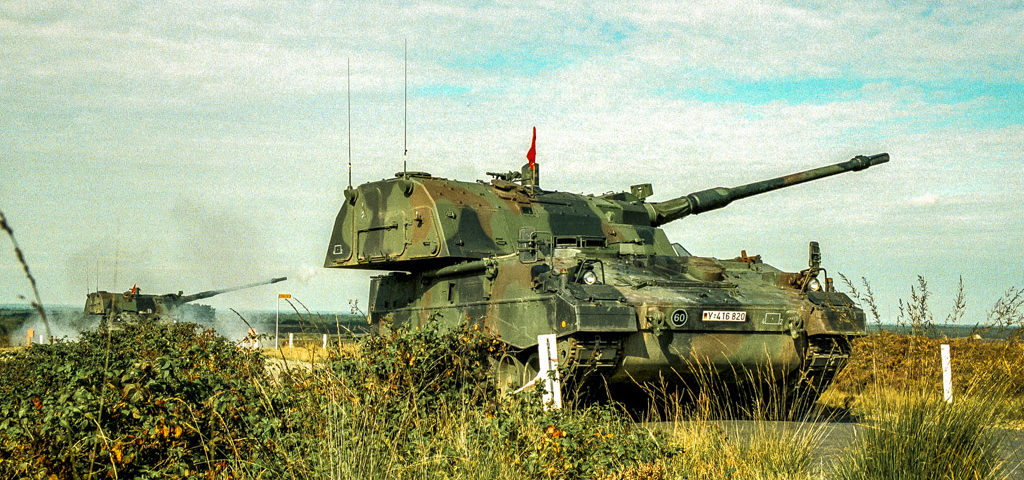

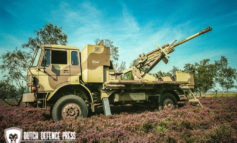
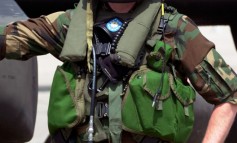
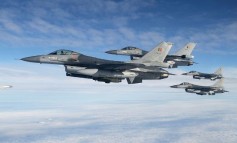
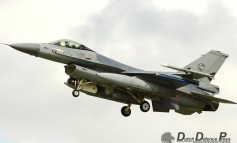



Leave a Reply